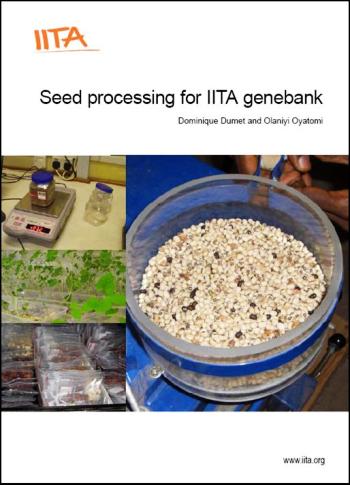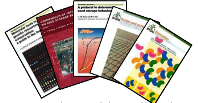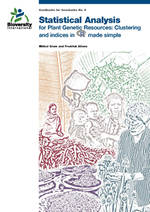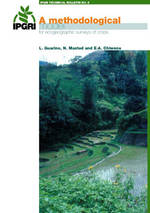CGKB News and events Manuals and handbooks
Seed processing for IITA genebank

|
Download this manual in pdf format here (0.6MB)
This manual explains how seeds are processed at the genebank of the International Institute of Tropical Agriculture (IITA)
Written by Dominique Dumet and Olaniyi Oyatomi
Contents of the manual
1. Harvest
2. Predrying
3. Threshing and purifying
4. Fumigation
5. Seed cleaning, purifying, and identity check
6. Seed drying
7. Water monitoring during drying
8. Seed sorting for germination and sample water content check
9. Water content determination for storage
10. Germination
11. Seed counting and weighing
12. Packaging
13. Storage
14. Sample sorting for distribution after storage
15. Shipment
Establishment and management of field genebank

Click here to download this manual in PDF (1MB) |
Many important varieties of field, horticultural and forestry species are either difficult as their seeds, if produced, are recalcitrant or reproduce vegetatively. Genetic resources of such plant species are generally conserved in field genebanks. Despite the often-cited drawbacks, field genebanks provide easy and ready access to conserved material for research as well as for use. In addition, for a number of plant species the alternative methods have not been fully developed and hence the field genebanking is the most appropriate method. For species that have alternative methods, field genebank is still a major component of a complementary strategy for the conservation of their genetic resources. Despite the importance of field genebank in a plant genetic resources conservation system, the concepts and scientific principles for establishing and managing field genebanks are not very well understood by many workers.
This Manual, based on a regional training course attempts to clarify most of such principles. The Manual introduces the principle and concepts of genetic resources conservation and shows the role of field genebank in a complementary conservation strategy that is required to conserve and use most of genetic diversity in any genepool. It deals with the current status of seed and in vitro and cryopreservation so that the role of field genebank would become clear in an ex situ conservation strategy for crop genepool. Some legal aspects are considered that need to be taken care of while establishing a field genebank. The question of what material should be conserved in field genebank is dealt in a chapter while the genetic principles underlying the accessions conserved a field genebank are elaborated in another. Practical aspects of laying out the field plots and planting are described. The simple but important considerations such as soil heterogeneity and interplant competition are considered.
As noted earlier, the field genebank has a major role to play in characterization and evaluation, as it may be very difficult to plant another experiment in the case of a perennial species specifically for such purpose and the factors that need to be considered for combining the twin objectives, i.e. conservation and characterization are described. In addition, the material in a field genebank is readily available for utilization and how this utilization could be made without countermanding conservation role is discussed. In characterization and evaluation and utilization of genetic resources, modern biotechnology will play a major role and hence an introduction to biochemical markers is provided. Finally, any conservation effort should be cost effective to be sustainable and economics of conservation using field genebank are considered.
Author: Mohd Said Saad and V. Ramanatha Rao, editors
Publication Year: 2001
Pages: 122
Format: A4
ISBN-10: 92-9043-464-3
ISBN-13: 978-92-9043-464-1
Language: English
Manuals and handbooks
 |
Please click on a topic of interest in the left hand menu.
In this section you can find manuals, handbooks and technical bulletins about germplasm (processing) and genebank management.
Some of these books discuss general genebank procedures, others show what do with the germplasm of a particular crop and finally, there are also genebank operations manuals of some CGIAR centres that might be very informative and useful for other conservation programmes.
These materials can be used by a variety of audiences including researchers, technicians and university lecturers, among others.
Methods and statistics
 |
Handbooks for Genebanks No. 9:
Statistical analysis for plant genetic resources: clustering and indices in R made simple
This handbook aims to give researchers tools and methods to analyse mathematically complex morphological characterization data. R is a powerful software language and environment for statistical computing and graphics, developed by volunteers from around the world, working together over the Internet. The core development team consists of fewer than twenty programmers who maintain and develop the general R environment, with contributions from many others. A much larger number of contributors write individual statistical packages for R that address specific needs. Statisticians and researchers write many of these statistical packages for their own research purposes, ensuring that R is in the forefront of developments in statistics. Another of R's strengths is the ease with which well-designed publication-quality plots can be produced, including mathematical symbols and formulae where needed. On the down side, if you are used to pointand-click interfaces, you may find that R has a relatively steep learning curve. As one of the developers of R once put it, R is not designed to make easy things simple, but to make difficult things possible. Nonetheless, several projects are working on making R easier to use, and interfaces should improve in the near future. We would not propose R had we not found that it has many facilities useful to the analysis of plant genetic resources data, facilities not commonly found in other statistical packages. We also believe that with a step-by-step guide, providing examples of typical analyses required in plant genetic resources research, most researchers will be able to implement such analyses quite simply on their own data. This tutorial provides such a guide, beginning with simple examples that soon demonstrate the power of R, and allows users to gradually become acquainted with the more complex aspects. Just enough explanation of the statistics is given for readers with a basic understanding of the subject to understand the output of the analyses.
Authors: Grum, M.; Atieno, F.
Publication Year: 2007
Pages: 40
ISBN-13: 978-92-9043-735-2
Language: English
 |
IPGRI Technical Bulletin No. 4: Design and analysis of evaluation trials of genetic resources collections: A guide for genebank managers (0.2MB)
This guide is for genebank managers who are considering undertaking evaluation trials on the genetic material in their care. It covers the stages involved in an experimental programme, from the determination of the objectives of each trial to the methods used for the analyses: a broader subject area than that of 'traditional' statistics. The coverage can only give general guidelines, and managers will need to interpret and adapt them for their particular crops. This guide discusses some of the statistical issues that should be borne in mind when conducting an evaluation trial. Managers will also need to consider practical aspects of the way their crops should be grown. A compromise between statistical and practical consideration can be found. This document is intended to stimulate discussion with and among genebank managers on how they could be using their genetic materials to the fullest.
Publication Year: 2000
Pages: 53
ISBN-10: 92-9043-505-4
ISBN-13: 978-92-9043-505-1
Language: English
 |
Boletin Tecnico IPGRI No. 8: Anàlisis Estadístico de Datos de Caracterización Morfológica de Recursos Fitogenéticos (3.3MB)
Para la preparación de este boletín se tuvieron en cuenta varios Estudios de Casos en los que se incluyen como objetivos de la caracterización: (1) la medición de la variabilidad genética de la colección de germoplasma; (2) el establecimiento de la representatividad de los ejemplares en la colección en relación con la variabilidad del germoplasma en una región o con la variabilidad total de la especie involucrada; y (3) la caracterización de la estructura genética. Otros objetivos, no utilizados en los estudios de casos en este boletín, son la identificación de duplicados en una colección y la detección de genes especiales o alelos particulares, bien sea solos o en combinaciones únicas, que se expresan en caracteres morfológicos en diferentes estados.
En este boletín se hace énfasis en el análisis estadístico de los datos de caracterización morfológica como el primer paso para estudiar la variabilidad genética y se presentan, en forma general, las diferentes técnicas estadísticas que facilitan un mejor entendimiento de dicha variabilidad. Sin embargo, los editores quieren llamar la atención del investigador indicando que en la temática no se incluyen técnicas estadísticas relacionadas con la biología molecular la cual ha agregado nuevos conceptos y herramientas para un mejor entendimiento de la variabilidad y donde, igualmente, el análisis de datos juega un papel importante.
Aunque los actuales avances derivados de la biología molecular han proporcionado nuevas técnicas para la caracterización de germoplasma, la aplicación de éstas todavía no se ha generalizado en la mayoría de los bancos de germoplasma de la región. Así mismo, los desarrollos en los sistemas de información geográfica (SIG) están facilitando la identificación de las condiciones predominantes en los sitios de origen de las especies vegetales. En consecuencia, gracias a estas herramientas modernas la caracterización está tomando una nueva orientación hacia el análisis integrado que incluye varias disciplinas para una mejor comprensión de la variabilidad genética de las colecciones de germoplasma.
Se espera que las técnicas aquí descritas sean útiles para los investigadores en recursos genéticos y curadores de colecciones de germoplasma que trabajan en forma exclusiva con descriptores morfológicos.
Authors: Franco, T.L.; Hidalgo, R. (eds.)
Publication Year: 2003
Pages: 90
ISBN-10: 92-9043-543-7
ISBN-13: 978-92-9043-543-3
Language: Espanol
 |
IPGRI Technical Bulletin No. 9: A methodological model for ecogeographic surveys of crops (1MB)
The publication is aimed at curators and other genebank staff. It is meant to be a discussion guide, to provide ideas and suggestions on how management procedures can be improved, and to point to possible implications of a given management procedure. It does not aim to provide a definitive theory on composing genebank collections or on the management of accessions, nor does it attempt to provide a complete overview of possible approaches and procedures. The reader is invited to give feedback to IPGRI (comments, additions, alternative approaches, etc.) on any aspect of the contents, and thus contribute to the discussion started with this publication.
Author: de Vicente, M.C. (ed.)
Publication Year: 2005
Pages: 55
ISBN-10: 92-9043-690-5
ISBN-13: 978-92-9043-690-4
Language: English



 Manuals and handbooks
Manuals and handbooks
